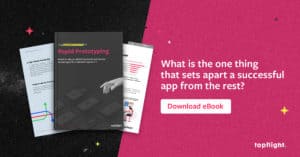While no one in their right mind starts a marketplace app to take on Uber or Airbnb, the market is still ripe for new service-focused marketplace applications.
According to the Bureau of Economic Analysis, we spend 70% on services. Yet, only 7% of the services we purchased in 2019 were digital. Well, that’s about to change especially on the back of the COVID-19 pandemic.

With online sales growing (up 37% from 2019), we thought it’s time to rehash everything we know about custom mobile marketplace development and provide you with a simple guide on how to create a marketplace app. Because the market is waiting.
Table of Contents
- What’s a Marketplace App?
- Brief History of Marketplace Apps
- Types of Marketplaces
- Top 5 Marketplace Apps Worth Stealing From
- Challenges to Building a Marketplace Platform
- Build a Winning Marketplace App — 5 Steps to Success
- Technology Stack for Developing a Marketplace Application
- Marketplace App Monetization Strategy
- How Much Does it Cost to Make a Marketplace App?
- Our Experience with Online Marketplace App Development
What’s a Marketplace App?
Marketplaces are where we buy stuff, right? Well, a marketplace in the palm of your hand is the same, except it trades products and services.
The most recent trend is to commoditize and package a professional into a product, but we’ll talk about that in the next section. Besides marketplace, it also helps to know such terms as:
- Disintermediation — removal of an intermediary in an exchange process, e.g., replacing taxi operators with algorithms.
- Network effect — every new buyer and seller adds an accumulative positive effect to the whole network.
Brief History of Marketplace Apps
I bet you’d like to know what marketplace apps have the best chance at succeeding before you start building an MVP. One way to do that is by looking at marketplaces through a historical prism.
Li Jin and Andrew Chen at Andreessen Horowitz (a16z) has compiled an insightful timeline of marketplaces from the 90s till the present days. If you check out their chart, you’ll notice that mobile marketplace apps really kicked in only in 2009, two years after the initial iPhone release. That has been a very prolific decade for Uber-for-X, aka on-demand, marketplaces.
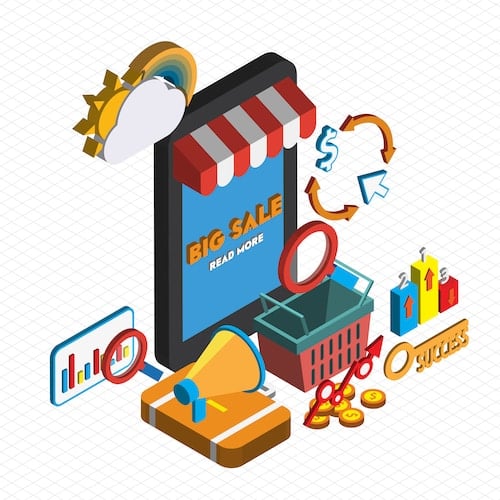 At the same time, only a few major retailers (like Amazon) chose to create a mobile marketplace in the early 2010s: eBay, Amazon, Etsy, AliExpress, and Newegg, among a few others.
At the same time, only a few major retailers (like Amazon) chose to create a mobile marketplace in the early 2010s: eBay, Amazon, Etsy, AliExpress, and Newegg, among a few others.
Since the mid-2010s, we’ve seen more managed marketplaces popping up. These are platforms like Upwork that take on more responsibility to manage or oversee providers as they deliver goods and services.
Today, a16z believes that marketplaces that unlock supply for regulated services industries, law, finances, or healthcare, will have greater chances of scaling rapidly. So, if you are in the healthcare business and want to create platforms that connect doctors and care providers with patients, you’re on the right track.
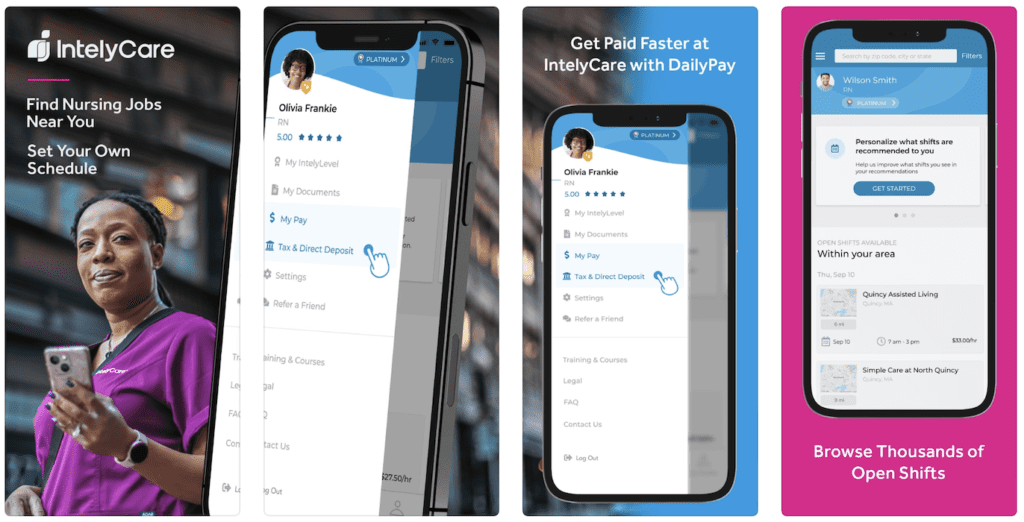
Image credit: App Store, IntelyCare (all rights belong to Apple Inc.)
- on-demand nursing
- on-demand therapy
- mobile medical equipment shops
These are just a few use cases for building sustainable marketplace apps in healthcare.
Read also: How to Build an On-Demand Service App
How to Create an App like Uber for Marijuana
Types of Marketplaces
Not all marketplaces are created equal. I think it helps to know at least the most popular types of marketplace apps based on various criteria. It may spur your own vision to create an app for the marketplace that’s most promising.
by commodity: goods, services, and staffing
The first thing that comes to mind when you try to categorize marketplace apps is the commodity traded in the app. Customers use these tools to buy:
- physical goods like electronics or books
- services like tutoring or housecleaning
- staffing like filling a nursery shift or hiring a site developer
by structure: marketplaces and market networks
There are true marketplaces like Airbnb, where customers focus on the commodity — we do read reviews and check out owners’ profiles, but our focus remains on finding a great place to visit.
Market networks are special marketplaces where both sides are interested in creating a reputable profile and building a network of connections. In such a network, we are more interested in the personality of a service provider we pick.
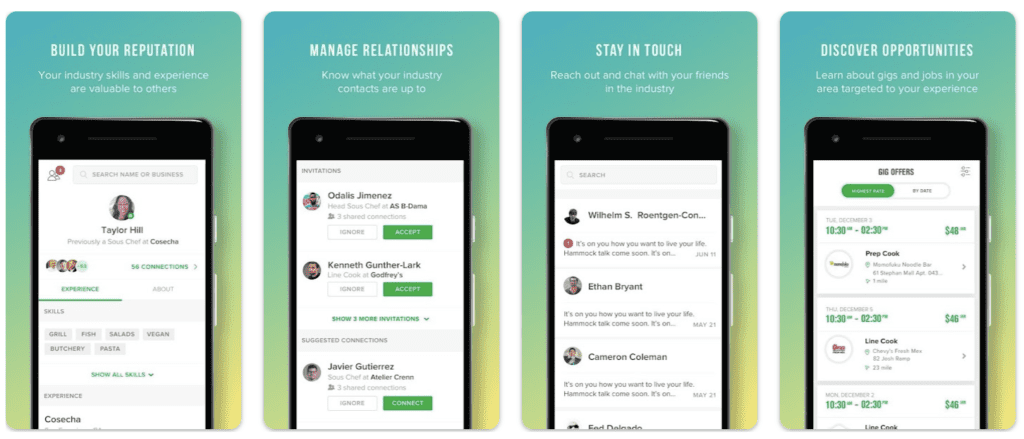
Image credit: Goole Play, Pared (All rights belong to Google LLC)
Pared is a shining example of a market network where restaurant workers create relationships among themselves and restaurant owners. It’s noteworthy that participants can switch places in market networks, like friends taking turns to help each other with babysitting in the Helpkin app we developed.
by participants: two-sided and multi-sided
When I order a ride in Uber and a driver comes to pick me up, it’s a 2-sided marketplace. I’m on the one side, and Uber is on the other side. But when I place an order on DoorDash, I can pick from various restaurants — that’s a multi-vendor marketplace.
by target audience: B2B, B2C, C2C
Depending on who’s serving who, we can discern business-to-business (Dial4Trade — a b2b marketplace), business-to-consumer (Instacart — a b2c marketplace), and consumer-to-consumer (Letgo — a c2c marketplace) marketplaces.
One word of advice here: carefully pick the right niche before you start custom mobile marketplace development.
Top 5 Marketplace Apps Worth Stealing From
What marketplace apps do we pick to make it really worthwhile for you to even glimpse through the list without “catching up” on the old news like Airbnb and Uber.
In other words, what examples of mobile marketplace apps can really help you answer “How to create a marketplace app?”
After analyzing a couple of the lists ranking marketplaces 1 to 100, like this one by a16z, and checking on the CB Insights’ United States Of Startups, I decided we should go with these:

- OfferUp, a shopping app for buying and selling online
- ZocDoc, an on-demand doctor platform
- Postmates, eats delivery
- Udemy, course creators meet students
- Sittercity, childcare network
Why? The top five categories in the marketplace 100 list by a16z include shopping, food & beverage, education, health & wellness, and childcare. And by the way, Andrew Horowitz compiled the list by analyzing where users spend most dollars.
Let’s see what we can take away from these marketplace apps before we create a mobile marketplace of our own.
OfferUp
Founded: 2011
Type: c2c marketplace
Description: mobile peer-to-peer marketplace app (aka p2p marketplace) to buy and sell electronics, cars, and everything in between.
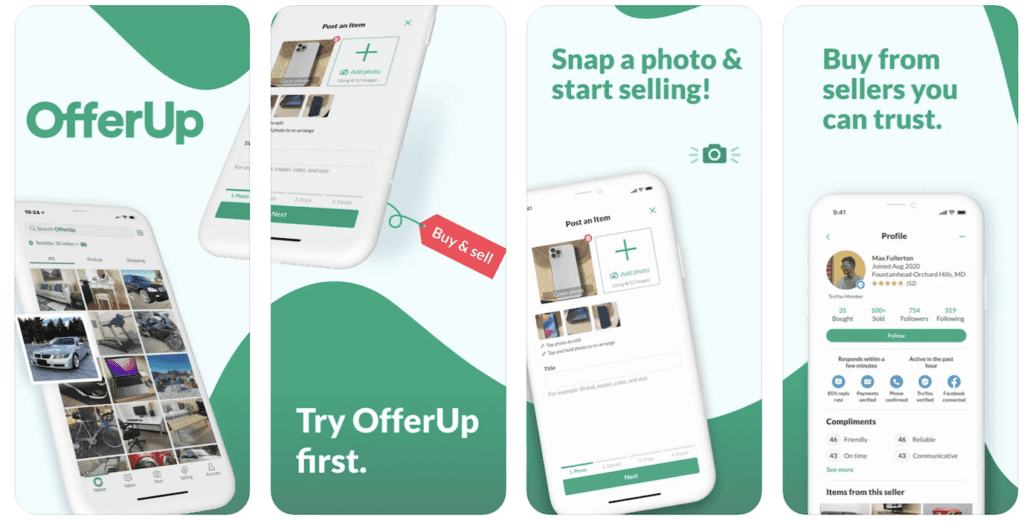
Image credit: App Store, OfferUp (all rights belong to Apple Inc.)
Killer features:
- TruYou verification that includes a state-issued ID, phone number, and a photo
- showing previous transactions for all users
- search alerts
As you can see, the first two features help with establishing trust between sellers and buyers, and the last one notifies buyers about new items matching their search criteria.
ZocDoc
Founded: 2007
Type: b2c marketplace
Description: on-demand doctor appointment-booking platform that brings together patients and doctors.
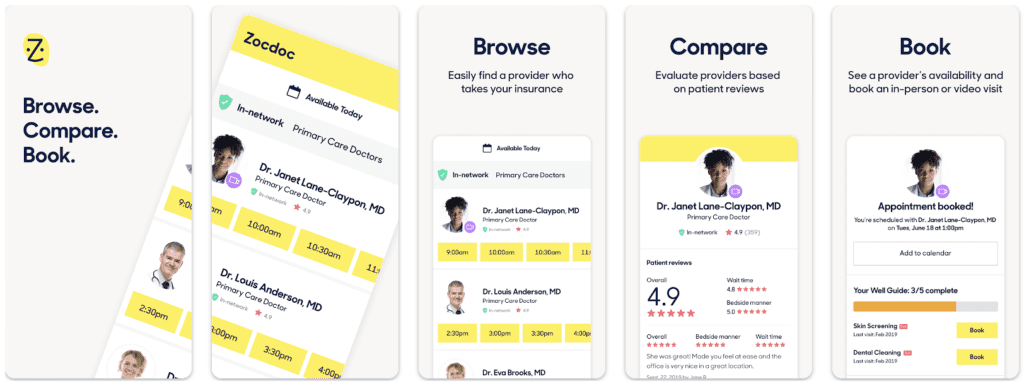 Image credit: Google Play, ZocDoc (all rights belong to Google LLC)
Image credit: Google Play, ZocDoc (all rights belong to Google LLC)
Killer features:
- insurance checker to find doctors that match the patient’s plan
- featured doctor reviews
- appointment scheduling
Postmates
Founded: 2011
Type: b2c/b2b marketplace
Description: on-demand restaurant meals delivery service (acquired by Uber in December 2020).
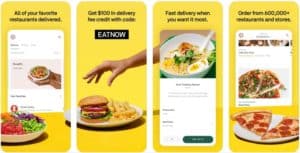
Image credit: App Store, Postmates (all rights belong to Apple Inc.)
Killer features:
- hot spots in the delivery-side app, showing the best areas to pick up orders
- subscription for frequent users to avoid delivery fees
- special option to order time-limited offers from trending places
Udemy
Founded: 2009
Type: c2c/p2p marketplace
Description: courses serving platform
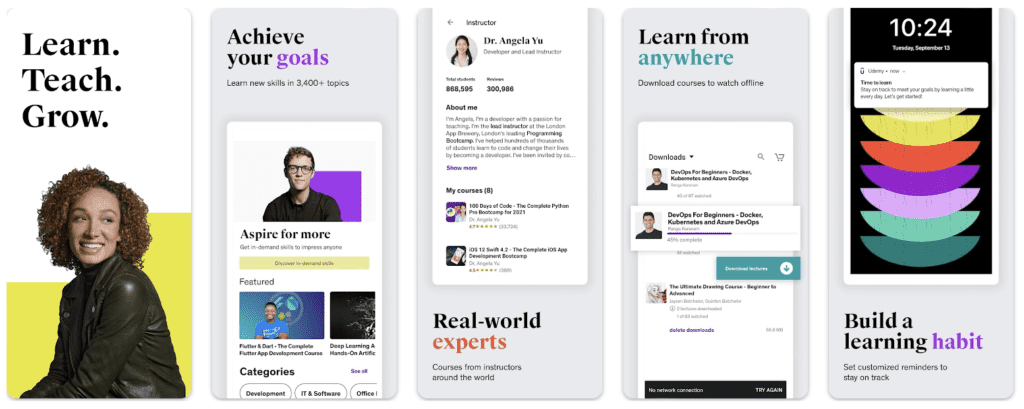 Image credit: Google Play, Udemy (all rights belong to Google LLC)
Image credit: Google Play, Udemy (all rights belong to Google LLC)
Killer features:
- saving courses for offline viewing
- casting video playback to a TV
- note-taking
Sittercity
Founded: 2001
Type: c2c/peer-to-peer marketplace
Description: a platform for hiring local babysitters, nannies, pet sitters, senior care providers, and housekeepers.
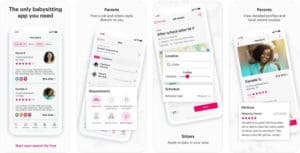
Image credit: App Store, Sittercity (all rights belong to Apple Inc.)
Killer features:
- nanny background checks
- search filters by skills and experience
- secure in-app messaging
Note that all of these apps take good care of both providers and buyers. This seems to be the right way to establish a long-term relationship with both parties and start a marketplace app that becomes an instant hit.
What marketplace app to build
What’s interesting is when you look at the United States Of Startups — they list top-funded tech startups for each state — you see that out of 50 most well-funded startups, 16 are marketplace apps. That’s 30%.
If we zoom in, we’ll notice that three of these startups are healthcare-related, and two are fintech marketplaces. The rest are all over the place and have to do mostly with offering professional services in various industries.

How can you use that? Think of a healthcare or fintech marketplace platform (two-sided or multi-tier) that can solve issues for patients, providers, vendors, insurers, and other market players. The niche is huge (I don’t think we need to quote the figures here; it’s billions of dollars) and desperately needs democratization. So, come up with a unique value proposition and start building.
Challenges to Building a Marketplace Platform
Chicken-egg issue
You’re probably aware that a real pain point with growing a marketplace app is onboarding the demand side when there’s still no substantial supply and vice versa. Because when you create an app for the marketplace, you need to attract both sides simultaneously.
How do you get users to sign up for your new hyper-local delivery service when you have no partnerships with local restaurants? How do you get new restaurants to partner up and sign up if there’s just a handful of users at the time?

Some would say it’s a purely marketing challenge: you need to ramp up your ad budget and hire an ingenious growth hacker. While this may be indeed the route that solves the chicken-egg issue, I still suggest that you check what can be done right inside the application to address this challenge while building a marketplace app.
Tips:
- the app should be super easy to share
- use deep linking with referral codes for effective referral programs
- use services like AppsFlyer to know what channels bring most users
- offer an API to integrate with other apps for cross-promotion
At the same time, never stop building more partnerships while creating a marketplace app.
Little control over inventory quality
What I mean here is you, as a marketplace app owner, have certain limitations on the control over providers’ services or products delivered through the platform. Therefore, you need to hand over these functions to buyers.
Tips:
- implement a spam-flagging system
- add verifiable reviews and ratings
- make reviews non-editable after some time to avoid manipulators
Ceding such supervision functions to end users helps create marketplace apps that are more trustworty.
Disintermediation
Disintermediation is a clever word for taking buyer-seller interactions off the marketplace app.
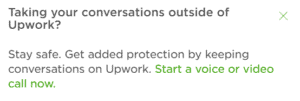
Unfortunately, that’s the harsh reality many founders building a marketplace application need to consider if interactions on a platform between demand and supply are frequent and depend on personal connections.
For example, you would likely hire a house cleaning person after they’ve cleaned your house a couple of times, and you’ve established some personal relationship.
Tips:
If you have much supply, you can try to make it programmatically impossible to match the same buyer and providers after the first interaction. Another possible countermeasure is to offer buyers a discount for the next order, which stimulates them to come back to the app for new purchases.
Otherwise, it’s mostly an out-of-app issue that you can solve by offering mediation services, guarantees, etc.
Commoditization of services
If you think about it, services are tough to commoditize. What some buyers may value as a 5-star experience, others will regard as a subpar service. So how do you bring everybody to common ground in a multi-vendor marketplace?
Tips:
- add buyer and seller profiles, with a detailed history of previous orders/jobs
- think through the rating system and adjust it to reflect the most recent experience
- give providers an option to offer buyers pre-packaged services (like Upwork does)
Hopefully, these tips will help you understand how to build a marketplace app, taking into account the above mentioned limitations.
Build a Winning Marketplace App — 5 Steps to Success
If you’ve already read a few how-to blogs about service marketplace app development, you probably already know all the major steps of the development process:
- market research
- rapid prototyping (includes design) + user testing
- development + testing
- release + maintenance
Even though online marketplace app development includes all these steps, there’s still something different when you develop a marketplace app compared to many other mobile applications. What’s the difference?
First, please take a look at this wonderful illustration from the TaskRabbit founder’s blog The Anatomy of a Marketplace:
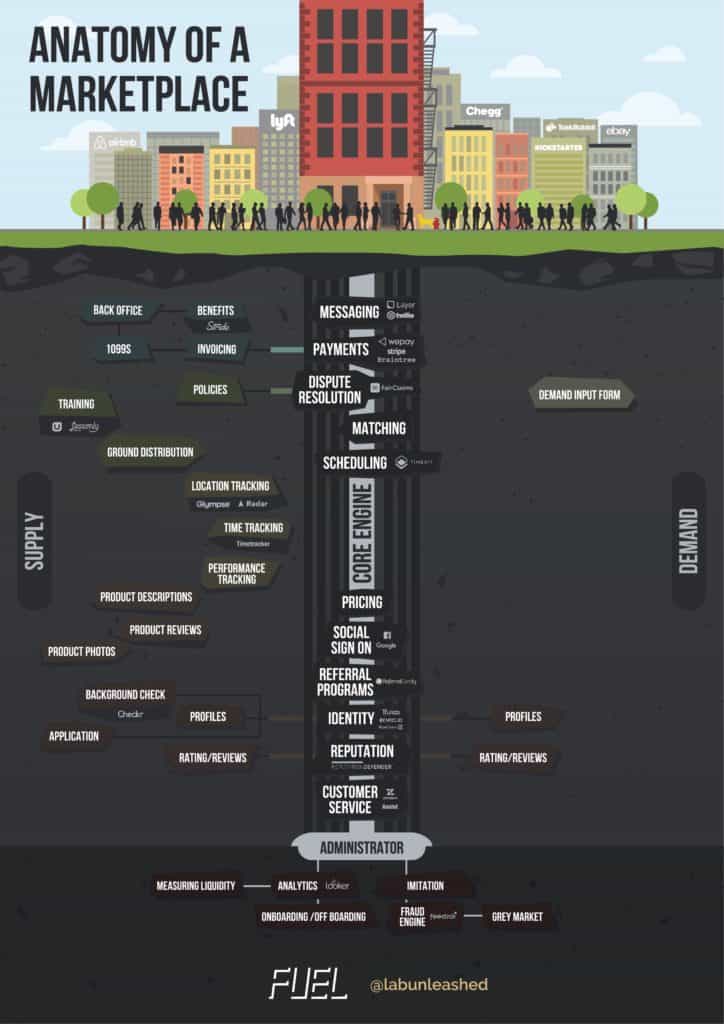
Everything you see on the surface is how we often see a marketplace app. Everything under the ground is what makes the customer-facing app tick. And this underground chunk of platform development takes time and tech skills to develop.
Step #1: Build the boring block
The boring block of marketplace application development is a back end with an admin interface. That’s where your app logic will reside, that’s where smart algorithms matching buyers and sellers will run; that’s the magical core engine of your marketplace app.
And the admin panel lets your employees manage the whole process from start to finish: from the moment an order is placed to a transaction to a service/product review.
Even if you’re working on a seemingly self-regulated marketplace app like OfferUp, in some cases, you’ll still need to mediate conflicts, manage transactions, regulate user actions, etc.
So we’re talking about a decent custom developed web application here. It’s not going to be as fancy as Gmail or other state-of-the-art web solutions but will definitely require substantial effort to create.
Step #2: Build the fancy stuff
The fancy stuff is the consumer marketplace app — the one we use to order a pizza, ride, or house repairs. It has to be fancy by definition because customers have become picky since the early iPhone days.
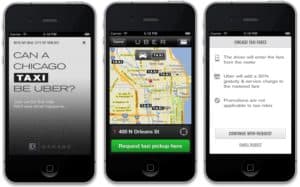
From the customer perspective, the most vital part of any marketplace app is the commodity. So you want to apply additional effort to polishing a product page:
- description of goods or services
- user reviews and rankings
Here are some other features to consider if you want to develop a service marketplace app that appeals to buyers:
- registration and authorization
- user profiles for sellers and buyers
- catalog of products or services with search and filters
- shopping cart
- in-app messaging and push notifications
- real-time geolocation for matching with providers
All in all, the customer-facing marketplace app is how most people envision any marketplace app. However, as we’ve already established, there are more pieces of this puzzle: you need to consider the core engine part to orchestrate the app. But wait, there’s more.
Step #3: Build the not-so-fancy stuff
Mobile app development for marketplaces should always include a dedicated app for providers or sellers (iOS + Android). Yes, drivers need to receive ride requests with user profiles (that they get to pick, by the way), sellers need a place to upload their products, and a car mechanic needs a profile to fill.
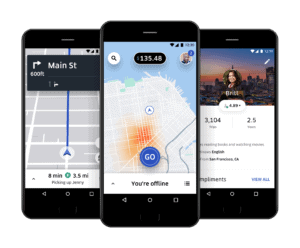
If you’re working on a lean budget, that’s another burden. To minimize the effort required to create a provider app, many companies move profile filling features and everything else not related to order activities to a web application, which is cheaper to produce.
However, things like messaging and order requests (basically everything that has to do with service/product delivery) find their place in the mobile app.
What’s great about provider apps is that you don’t need to spend too much time making them fancy. When you’re just starting, sellers consider your application as a potential add-on revenue stream and kind of have to stick with whatever you provide.
Of course, it goes without saying that the UI/UX design should still be well-thought-out. Otherwise, providers may think it’s not worth the effort to register with your app. For example, it’s a well-known fact that taxi drivers flip from Uber to Lyft if there’s a better order. If your marketplace ensures providers receive a steady flow of orders and a super easy-to-use interface, your app will win.
Step #4: Take legit tech shortcuts
Given the development of a marketplace app turns out such a massive undertaking, I recommend using third-party off-the-shelf components to implement commonplace features like payment gateways.
For example, when Leah Busque began working on TaskRabbit back in 2008, they had to create a background checking mechanism themselves. Today, to build a complete marketplace app, we can use services like Checkr that we can plug in a matter of days instead of wasting months worth of development effort.
Here are some examples of SDKs and APIs that you can use as ready-made parts for your marketplace app:
- Authentication (social media logins): Google, Facebook, Twitter, Apple ID, Auth0
- Chat: Twilio, SendBird
- Mapping: Google Maps, Apple Maps, Mapbox, Carto
- Payment methods: Stripe, PayPal, Skrill
- Back-end: Firebase, Parse
You can find more APIs for your marketplace app here. Or you can really zoom in on that image by Leah Busque (click on the image when you open it to enlarge and see what she suggests using for different parts of a marketplace app).
Step #5: Post-release
One thing that’s different in the case of marketplace mobile app development is once you release a marketplace platform, you must manage its content to curb rules violations like spam or inappropriate imagery.
All that is available via your dashboard application — part of your core engine we spoke about above. And of course, users should be able to easily flag inappropriate content.
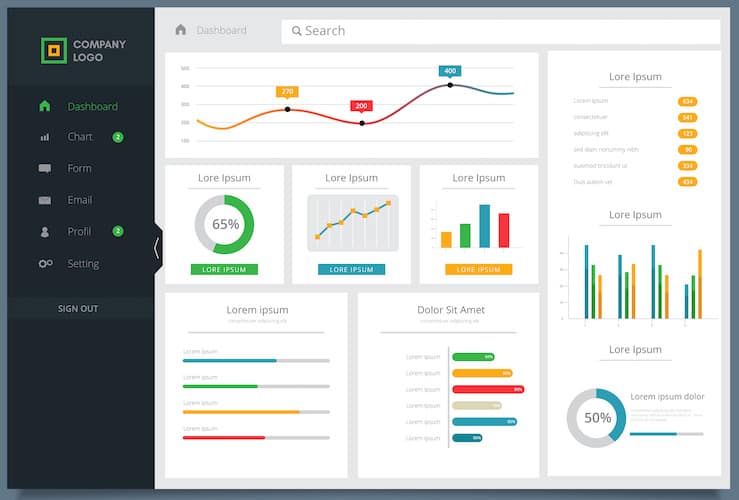 As with any other application, once it’s released, you need to keep it up-to-date with new OS versions and analyze app usage metrics to optimize user experience going forward.
As with any other application, once it’s released, you need to keep it up-to-date with new OS versions and analyze app usage metrics to optimize user experience going forward.
As you can see, it’s one thing to develop a marketplace app, and it’s totally different to maintain it. Please note that we’re leaving marketing and search engine optimization out of this equation, focusing solely on product development.
Technology Stack for Developing a Marketplace App
You might wonder, “What tech skills does it take to deliver a robust marketplace application?” To tell you frankly, you can pick practically any tech stack for developing a marketplace app.
Anything that’s scalable and includes a high-performance database will work. Therefore, you are not bound to any particular tech skillset.
However, please bear in mind that the skillset needed to build a mobile marketplace app must cover quite a few areas of expertise. On a high level, the tech skills for creating an online marketplace mobile application include:
- front-end and back-end development
- design and prototyping
- automated and manual testing
- DevOps
At Topflight, we love using React Native to build a complete marketplace app for android and iOS, and React.js/Node.js/Amazon Web Services for the web application. Mongo.DB serves as a great database choice, and if you’d like to get more specifics, I encourage you to book a call with our experts here.
Marketplace App Monetization Strategy
You’re planning to make a marketplace platform not only to bring value to service providers, sellers, and buyers but to make money, too, right? Fortunately, the beauty of the marketplace business model is having an option to charge on both ends: sellers and buyers.
The typical course is to set up a payment system that applies transaction fees or introduce a listing fee for e-commerce sellers. Other monetization models, e.g., freemium or pay-to-download, simply won’t work because you won’t be able to charge for new features once updates start rolling after the first version.
And with a subscription model, you can count only on the most active users adopting it and risk leaving too much of a profit on the table. Mobile advertising will be hard to pull for the same reason.
How Much Does it Cost to Make a Marketplace App?
The average cost of developing a marketplace app is somewhere between $160,000 and $240,000. The good news is you can start by investing in rapid prototyping to get an interactive prototype of the app which will not only help validate your idea but also reduce app development costs. The cost to build a prototype is between $15,000 to $20,000.
Having a prototype helps because you can run user tests and see how users accept your idea before writing a single line of code. We’ve found rapid prototyping to be an ideal fundraising tool for early-stage startups. Companies we work with raised $188 million using prototypes. So, consider prototyping as a means to keep the lid on the budget during custom marketplace Android app development.
One word of advice is to never pick an app development company based on an hourly rate alone. Look for a partner who can help you release an MVP to start getting traction within a reasonable timeframe.
Our Experience with Online Marketplace App Development
Our experience in mobile app development for marketplaces is mostly confined to healthcare, fintech, and on-demand projects. Here are some of the most recent marketplace projects we completed in these niches.
#1 Sherpa: a platform that brings together financial advisors and people looking to take their budgets under control.
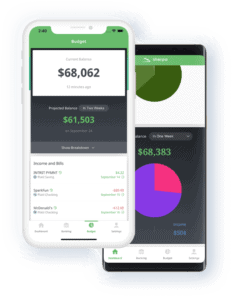
Users download a mobile app that analyzes their spending habits and projects future budgets accordingly. Financial advisors sign up for a web application that is integrated with the mobile app to provide personalized recommendations to Sherpa’s users.
Learn about how we made that work in a case study.
#2 Helpkin: a marketplace network that allows friends to trade babysitting and dog-walking services. Users schedule their availability hours in mobile apps (iPhone and Android) and easily coordinate with their pals.
More info on how we refurbished the app and made it an acquisition target in the case study.
If you are looking to create your own marketplace app, schedule a call with our expert and learn how our app development company can assist.
[This page was first published on 12/17/2020, and has been updated for more recent data]
Frequently Asked Questions
Do I need to build 5 apps (iPhone and Android for buyers + iPhone and Android for sellers and providers + web application for managing the platform)?
Some marketplace apps, especially those having to do with trading stuff, make do with a single mobile app that works for sellers and buyers
What types of marketplaces look most promising today?
Platforms that connect professional, regulated service providers with buyers and b2b marketplaces.
Is there a fireproof tech stack that I should pick for my marketplace?
You can go with many different tech stacks. That’s the last thing you should worry about. There’s plenty of resources, and the pricing is not much different from one tech stack to another.
What are some ways I can reduce the development budget?
Start a marketplace app with a rapid prototype and use “as-a-service” components wherever applicable, e.g., Firebase for the back-end.
Can I do a very basic app for providers since I'm more concerned about the buyer experience? That would help me reduce the average cost of development.
It depends on the niche you’re serving. For example, Uber completely redid their Uber app for drivers some time ago — to provide them with an exceptional experience. The company spends hundreds of dollars onboarding new drivers, and so every little bit helps.
Should I create my own marketplace from scratch or use white-label solutions?
A marketplace that’s worth creating will serve unique needs and niche, which means you’ll have to tweak a ready solution into something that it may not fully support.
Do I absolutely need to include an online marketplace besides building mobile applications?
No, you don’t. If you don’t envision your users working with the app in their desktop browsers.



